Army Armor Modernizes In Slow Motion
Posted on
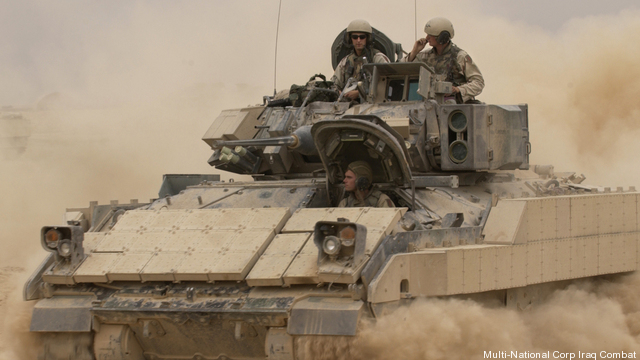
M2 Bradley
WASHINGTON: The US Army is deploying extra stocks of heavy weapons to Europe to deter Russia’s increasingly naked aggression. These are the most advanced ground weapons America can field — but the tanks and other heavy fighting vehicles in this buildup are the same ones we had the last time the Russians were a danger, back when they were the Soviet Union.
They have been upgraded, true, and the Army plans to upgrade them in the future. But no new designs are in the pipeline: There’s just research into promising technologies that might someday revolutionize armored fighting vehicles.
How we got here, and where we might go, is a story that gets to the heart of what the US Army is for.
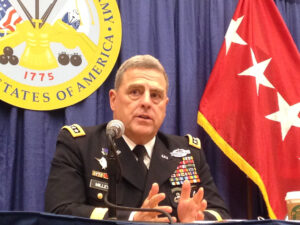
Gen. Mark Milley
“Our reason for being, our very reason for being, the very core of what it means to have an army, is to win and win decisively in ground combat against enemies of our country,” Gen. Mark Milley told the Senate Armed Services Committee during his recent confirmation hearing. The outgoing Army Chief of Staff, Gen. Ray Odierno, had often emphasized the Swiss Army Knife utility of Army units that were “scalable and tailorable” to any number of missions. His designated successor, Gen. Milley, made clear that the Army has many missions, but only one that defines it: “to win in the unforgiving crucible of ground combat.”
What does that mean? After 14 years of guerrilla warfare in Afghanistan and Iraq, Milley is saying the Army is no longer focused primarily on counterinsurgency operations, known as COIN. “I would put Russia right now, from a military perspective, as the No. 1 threat,” he told the senators. “They attacked and invaded Georgia, they seized Crimea, and they attacked the Ukraine,” he said.
It’s worth noting that the European Plain forms a natural invasion route running from Moscow to Paris that’s been used by conquerors from prehistoric Indo-European charioteers to Hitler’s blitzkrieg. Cold War planners feared the Red Army would roll west across the plain at its narrowest point, in Germany. Today, NATO’s easternmost partners, from Estonia to Poland to Romania, are exposed on the broadest part of the plain, the same wide-open spaces where the Wehrmacht ranged freely in 1941. If there’s one place on earth where large forces of armored vehicles are relevant, it’s here.

The European Plain has provided a natural pathway for invaders since prehistoric times (Wikimedia Commons)
“To assure allies and to deter Russian aggression, I think in both cases additional ground capabilities are necessary [in Europe],” Milley said. “The Army’s already moving out on that: It’s placed activity sets over there and prepositioned equipment.”
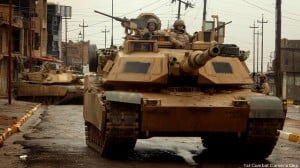
M1 Abrams tanks in Iraq
All that equipment, however, was designed and first fielded for the Cold War. It’s not that the Army hasn’t tried to replace these weapons. In fact, it spent two decades and billions of dollars trying to replace them. The Crusader howitzer, cancelled in 2002, was meant to replace the M109 Paladin howitzer. The Future Combat Systems, cancelled in 2009, were meant to replace everything, though most attention (and criticism) focused on replacing the M1 Abrams tank. The Ground Combat Vehicle, canceled last year, was meant to replace the M2 Bradley Infantry Fighting Vehicle.
Every attempt to field a new design has failed.
Now the Army’s got Future Fighting Vehicle contracts with the same two firms that worked on GCV and FCS before it, General Dynamics and BAE Systems. But FFV isn’t the same as the previous three-letter programs. GCV and FCS were designing specific vehicles the Army planned to buy: FFV is researching technologies that might go in a future vehicle that the Amy might design, someday.
The Army is buying one new vehicle, sort of. It’s buying a replacement for the venerable, vulnerable M113, something called the Armored Multi-Purpose Vehicle. But you could equally well call AMPV “the turretless Bradley,” since that’s what winning contractor BAE is building. In fact, many AMPVs may be conversions of existing surplus Bradleys. The main difference, besides the lack of a gun turret, will be AMPV’s superior electronics, engine, and suspension — but the Bradley will be getting upgraded to match soon.
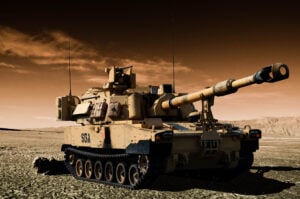
M109A7 Paladin PIM howitzer
In fact, rather than try yet again to invent an all-new vehicle, the Army is doubling down on the Bradley. The M109 Paladin is going through a Paladin Integrated Management (PIM) upgrade that largely keeps the turret intact but replaces the chassis with Bradley automotive components. The engine, suspension, transmission and other components on Paladin PIM, as on AMPV, will be the same ones the Bradley gets under an upgrade called Engineering Change Proposal (ECP) 1.
Overall, the Army expects 75 percent of the tracked vehicles in its future armored brigades to have the same power train and suspension, if not more. The remaining vehicles will be the M1 Abrams and its derivatives: the Joint Assault Bridge, Assault Breaching Vehicle, and M888 recovery vehicle.
“The real opportunity there is across those multiple platforms, you’ve got common components now: engine, transmission, drive train, final drives, track, road wheels, all the way down through the electronic,” said Mark Signorelli, general mananager for combat vehicles at BAE Systems, which builds the Bradley. The common components, in turn, allow the Army to reduce its logistics burden, the bane of heavy mechanized forces.
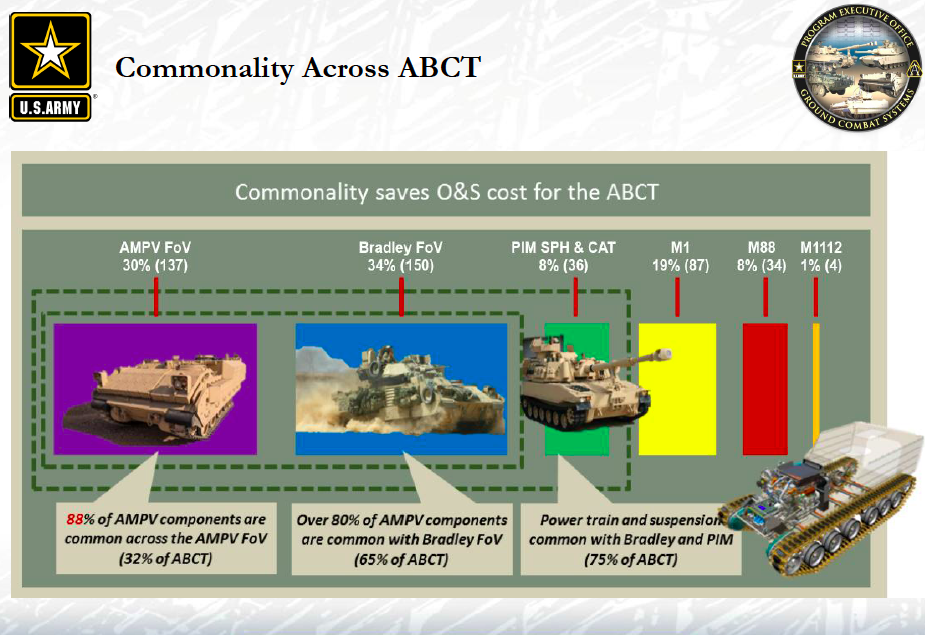
Armored Brigade Combat Team modernization plan
Anything that eases the supply and maintenance problem makes the force not only more affordable, but more deployable. Debates about airlift and expeditionary warfare tend to focus on the weight of individual vehicles, like the 70-ton M1. But most of the weight a unit has to move is not its vehicles, but fuel, ammunition, spare parts, and support personnel. While commonality across vehicles doesn’t reduce the need for fuel or ammo, it does reduce the number of different spare parts and differently trained mechanics.
The modernized Bradley family will have better automotive performance as well: Years of upgrades, especially uparmor kits to defend against roadside bombs, have made the Bradley awfully heavy. Most exciting for the Army, however, is the improved electrical power to run battlefield wireless networks, which will be part of a second upgrade package called ECP-2. (The M1 Abrams will get the same network upgrade as its ECP-1).
“It gives you the ability to do command and control differently,” said Col. Ken Harvey, director of concept development at the Maneuver Center of Excellence on Fort Benning, Georgia, part of Army Training and Doctrine Command (TRADOC). In particular, the mobile command post variant of the AMPV can follow the fighting forces much more closely than the fragile M113-based command vehicles it replaced. Currently, for example, tank and Bradley companies don’t have a dedicated command vehicle: The company commander and his executive officer ride in the same kind of vehicle as everyone else. That worked fine for the Cold War, but with the spread of networks and drones, Harvey said, “there was an exponential increase in data.” A command AMPV right behind the lines — run by the executive officer so the company commander can focus on fighting — could help sort that data fast enough to make it useful in battle.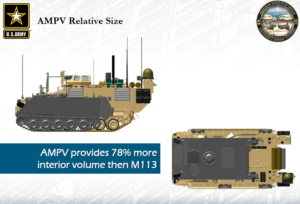
It’s remarkable that a vehicle designed in the 1970s, appropriately upgraded, can provide cutting-edge command for the 2020s. Looking at the original requirements for the Bradley and the M1 Abrams, “I’m amazed at how forward-thinking they were,” said Col. Chris Wilbeck, the TRADOC Capability Manager (TCM) for the armored brigade. The vehicles had room for growth that could accommodate the uparmor kits, roadside-bomb jammers, and other upgrades added for the Iraq War, he said. But the extra weight dragged down performance, the extra electronics upped power demands, Wilbeck said, so now “incremental upgrades is what we’re doing with the tank and Bradleys, which allow those vehicles to regain the capabilities we need them to have.”
But incremental upgrades only go so far. The Bradley will never fit more than six infantrymen in back, for example. In fact, it barely fits four troopers carrying a full combat load. The Bradley and Abrams engines, however improved, will never be fuel-efficient. The Bradley and Abrams hulls, however well uparmored, will never have the height off the ground or the blast-deflecting shapes that are optimal against IEDs.
More broadly, as long as it sticks with the Bradley and Abrams, the Army is stuck with the same tradeoff between weight and protection that has bedeviled tank design since the beginning. The Bradley grew from 25 tons to 34 over the years, largely from added armor. The Abrams grew from 60 to 70. The Ground Combat Vehicle designs reached 84 tons in some hypothetical high-threat configurations before it was cancelled.
Breaking out of that box is job No. 1 for the Future Fighting Vehicle program. “Currently the FFV program is doing an S&T [science and technology effort,” said Lt. Col. Scott Debolt, TRAODC’s chief of heavy systems requirements. With $720 million of funding over five years, BAE, General Dynamics, and labs across the Army are exploring the art of the possible to help shape what the requirement for a future vehicle would be.
The biggest challenge for FFV is finding a way to pack more protection into less weight. The best way to do that, Debolt, Harvey, and Wilbeck all agreed, requires replacing physical armor with so-called active protection system. The Israelis have deployed an APS called Trophy, which shoots down incoming projectiles with a kind of shotgun blast; but while fairly effective against explosive rounds, Trophy-type systems don’t stop solid shot — the kind used in kinetic energy anti-tank rounds. The Army’s objective APS is essentially a miniaturized missile defense that shoots down incoming weapons of all kinds before they impact.
The cancelled Future Combat System tried to rely on APS to let its lightweight vehicles survive, but the technology simply wasn’t ready yet. Is it now? Maybe.
“Can the system be reliable, effective, and useful enough to actually begin to replace physical armor?” said BAE’s Signorelli. “That’s probably on the cusp” of being a feasible, realizable system. Right now, he said, “we could probably demonstrate it. I don’t think it is combat-ready at this point.”
The Army can afford to wait. In fact, it can’t afford to do much else. Current budgets can accommodate incremental upgrades to current programs and long-term research towards future breakthrough. Any all-new design, however, will have to wait for not only new technology but new money.
Subscribe to our newsletter
Promotions, new products and sales. Directly to your inbox.
